flash flood
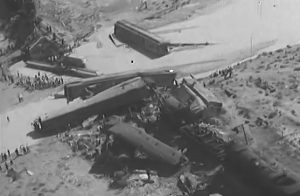 A sudden downpour near Terry, Montana on the evening of June 19, 1938 caused a flash flooding of the Custer Creek that would lead to a disaster before the night was over. Earlier in the day, a track walker was sent out the check the rail lines near Custer Creek which was located near the town of Terry, Montana. After his inspection, he reported to his superiors that the conditions were dry, and there were no problems with the tracks.
A sudden downpour near Terry, Montana on the evening of June 19, 1938 caused a flash flooding of the Custer Creek that would lead to a disaster before the night was over. Earlier in the day, a track walker was sent out the check the rail lines near Custer Creek which was located near the town of Terry, Montana. After his inspection, he reported to his superiors that the conditions were dry, and there were no problems with the tracks.
That was true at the time, but within a few hours, a sudden downpour overwhelmed Custer Creek. A small winding river, Custer Creek runs through 25 miles of the Great Plains before depositing into the Yellowstone River. Small streams like Custer Creek are prone to flash floods, because they don’t have  the capacity to handle any big influx of water, and their banks can quickly and easily be overtaken during heavy rains. As the water came rushing down stream, it washed out a bridge used by the trains. When the Olympian Special came through, it went crashing into the raging waters with no warning. Two sleeper cars were buried in the muddy waters. The night was pitch black seriously hampering rescue efforts. In all, 46 people lost their lives, and 60 others were seriously injured. The rear cars stayed above the water, but scores of passengers were seriously injured. They could not be evacuated until the following morning. I can’t even begin to imagine how awful that was.
the capacity to handle any big influx of water, and their banks can quickly and easily be overtaken during heavy rains. As the water came rushing down stream, it washed out a bridge used by the trains. When the Olympian Special came through, it went crashing into the raging waters with no warning. Two sleeper cars were buried in the muddy waters. The night was pitch black seriously hampering rescue efforts. In all, 46 people lost their lives, and 60 others were seriously injured. The rear cars stayed above the water, but scores of passengers were seriously injured. They could not be evacuated until the following morning. I can’t even begin to imagine how awful that was.
That was a tough week for Montana. Just a few days later, Black Eagle saw “torrents of water” that floated 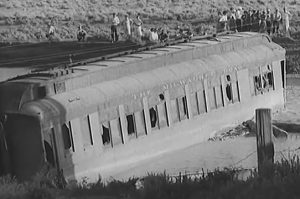 furniture in the house of Sam Tadich, the sheriff had to help a rescue effort, the road to Giant Springs washed away and water was up to cows’ flanks around the Sun River. Havre’s worst flood came in June 22, 1938, when a cloudburst in the Bear Paw Mountains sent out a wall of water. Ten people were killed. Floating train cars were wedged under the viaduct, 10 miles of highway were underwater between Laredo and Box Elder, with a bridge washed out, the Havre Daily News reported. Rain is a good thing, but too much rain, coming too fast can devastate an area, especially one with a creek or river, in a very short time, and for Montana, it was a very rainy week, making it a very tough week.
furniture in the house of Sam Tadich, the sheriff had to help a rescue effort, the road to Giant Springs washed away and water was up to cows’ flanks around the Sun River. Havre’s worst flood came in June 22, 1938, when a cloudburst in the Bear Paw Mountains sent out a wall of water. Ten people were killed. Floating train cars were wedged under the viaduct, 10 miles of highway were underwater between Laredo and Box Elder, with a bridge washed out, the Havre Daily News reported. Rain is a good thing, but too much rain, coming too fast can devastate an area, especially one with a creek or river, in a very short time, and for Montana, it was a very rainy week, making it a very tough week.
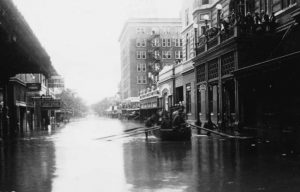 As the world watches, with sadness, the news of the flooding in Houston from Hurricane Harvey, I am reminded of another Texas flood that severely damaged a Texas city. This flood wasn’t from a hurricane exactly, but rather like Harvey, the flooding occurred because of too much rain for the ground to handle. Early that September, the remnants of a Category 1 hurricane brought heavy rains to areas of Mexico, as well as the state of Texas, particularly in the San Antonio area. On September 4, a tropical cyclone had developed in the southwestern Gulf of Mexico near the Bay of Campeche. It moved slowly in a general westward direction. Then, the storm reached hurricane intensity on September 7 prior to making landfall south of Tampico, Mexico the following day. The storm weakened over land, and lost cyclonic characteristics later that day, but a nearby high-pressure area forced the remnants of the system northward into Texas. So it was that was on September 7, 1921 in San Antonio, Texas, after some of the heaviest rainfall ever recorded in Texas…at least up to that time…dumped an astounding 23.11 inches of rain in the San Antonio area in less than a day.
As the world watches, with sadness, the news of the flooding in Houston from Hurricane Harvey, I am reminded of another Texas flood that severely damaged a Texas city. This flood wasn’t from a hurricane exactly, but rather like Harvey, the flooding occurred because of too much rain for the ground to handle. Early that September, the remnants of a Category 1 hurricane brought heavy rains to areas of Mexico, as well as the state of Texas, particularly in the San Antonio area. On September 4, a tropical cyclone had developed in the southwestern Gulf of Mexico near the Bay of Campeche. It moved slowly in a general westward direction. Then, the storm reached hurricane intensity on September 7 prior to making landfall south of Tampico, Mexico the following day. The storm weakened over land, and lost cyclonic characteristics later that day, but a nearby high-pressure area forced the remnants of the system northward into Texas. So it was that was on September 7, 1921 in San Antonio, Texas, after some of the heaviest rainfall ever recorded in Texas…at least up to that time…dumped an astounding 23.11 inches of rain in the San Antonio area in less than a day.
In some areas of Texas, the rainfall was even worse, but those areas somehow didn’t have the same potential for devastating floods. The precipitation peaked over Central Texas, where the highest rainfall amount measured was 40 inches near Thrall, Texas. This was the fourth highest tropical cyclone-related rainfall total in Texas since record keeping began. Similarly, an observation of 36.40 inches elsewhere in Williamson County, Texas ranked as the sixth-highest tropical cyclone-related rainfall total for the state. The high precipitation totals set nationwide records which would stand for several years. Like Hurricane Harvey, that storm stalled and the rain just kept coming.
The immense amount of rain quickly overwhelmed the San Antonio River that winds through southwest Texas. The area is usually pretty dry, but on that September day, the storm that stalled over Taylor, Texas was a 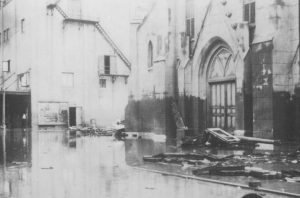 recipe for disaster. It was the heaviest single day of rainfall in the state to that time. Taylor is located 30 miles upstream from San Antonio, so when the flash flood came barreling down, it took aim on San Antonio with a vengeance. Most of the 51 flood victims were trapped in their cars by the surprise flood and drowned. Much like Houston, five to ten feet of water submerged the city’s streets, delaying an evacuation. The city was under water for nearly a week following the flood. The flood damage amounted to at least $5 million in damages in the small city that was San Antonio, at that time. In the aftermath, San Antonio embarked on a 10 year overhaul of its levee system, not knowing for sure that it would really help, but I guess they did what they knew to do.
recipe for disaster. It was the heaviest single day of rainfall in the state to that time. Taylor is located 30 miles upstream from San Antonio, so when the flash flood came barreling down, it took aim on San Antonio with a vengeance. Most of the 51 flood victims were trapped in their cars by the surprise flood and drowned. Much like Houston, five to ten feet of water submerged the city’s streets, delaying an evacuation. The city was under water for nearly a week following the flood. The flood damage amounted to at least $5 million in damages in the small city that was San Antonio, at that time. In the aftermath, San Antonio embarked on a 10 year overhaul of its levee system, not knowing for sure that it would really help, but I guess they did what they knew to do.
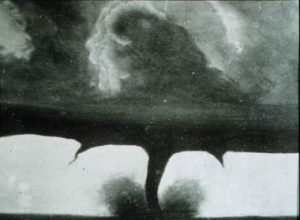 These days, tornado watches and warnings are a normal part of life. They may not happen every day, but when they do sound, we know what to do to stay as safe as possible. The warnings don’t always mean that there are zero deaths from a tornado, but they do help. Unfortunately, the tornado warning sirens, Doppler radar, and television warnings did not exist in 1884. In those days, people had to rely on the skies to tell them what was coming, and as most of us know, that is not always an easy task. In fact, it has taken hundreds of years to even begin to come close to perfecting a system whereby the public could be warned of approaching severe weather, and even then, it hasn’t eliminated the deaths that can occur from these storms.
These days, tornado watches and warnings are a normal part of life. They may not happen every day, but when they do sound, we know what to do to stay as safe as possible. The warnings don’t always mean that there are zero deaths from a tornado, but they do help. Unfortunately, the tornado warning sirens, Doppler radar, and television warnings did not exist in 1884. In those days, people had to rely on the skies to tell them what was coming, and as most of us know, that is not always an easy task. In fact, it has taken hundreds of years to even begin to come close to perfecting a system whereby the public could be warned of approaching severe weather, and even then, it hasn’t eliminated the deaths that can occur from these storms.
One of the largest and most widespread tornado outbreaks in American history happened at a time when warnings did not exist. It happened on this day February 19, 1884, and into February 20, 1884. The precise number of tornadoes, as well as fatalities incurred during the outbreak remains unknown. The outbreak was nicknamed “Enigma outbreak” and is well known by that name. Research of newspaper reports and governmental studies published in the aftermath reveals tornadoes, or in reality, long-track tornado families, struck Alabama,  Georgia, Illinois, Indiana, Kentucky, Mississippi, North Carolina, South Carolina, Tennessee and Virginia. It is estimated that at least 50 tornadoes struck those states that day. Some events that had been counted as tornadoes in initial studies, such as those by John Park Finley, were actually downbursts, especially in northern and northeastern portions of the outbreak. Nevertheless, the damage done was nothing to be overlooked.
Georgia, Illinois, Indiana, Kentucky, Mississippi, North Carolina, South Carolina, Tennessee and Virginia. It is estimated that at least 50 tornadoes struck those states that day. Some events that had been counted as tornadoes in initial studies, such as those by John Park Finley, were actually downbursts, especially in northern and northeastern portions of the outbreak. Nevertheless, the damage done was nothing to be overlooked.
The majority of the reported tornadic activity was seen across Alabama, Georgia, South Carolina and North Carolina, which were all struck severely by multiple waves of tornado families. In the Southeast, the outbreak began during the late morning in Mississippi, preceded by severe thunderstorms in Louisiana. Shortly thereafter, the outbreak widened and intensified, progressing from Alabama to Virginia between noon and midnight. In addition to the outbreak, wind damage, flash floods, with homes swept away by water in Louisville, Kentucky, New Albany, Indiana, and Jeffersonville, Indiana and other towns along the Ohio River, and Derecho-like effects in the Ohio Valley were also reported in published accounts of the outbreak. In case you didn’t know, a Derecho is a widespread, long-lived, straight-line wind storm that is  associated with a land-based, fast-moving group of severe thunderstorms. In addition to that, blizzard conditions occurred in the eastern Midwest, as a part of this storm series. According to an article appearing in the Statesville, North Carolina Landmark three days later, the damage tally in Georgia alone was estimated to be $1 million, in 1884 dollars. Today, the damage would have been approximately $23,660,667. That is an astounding figure, and that is just the property damage numbers. Loss of life simply cannot be measured in money. In fact, the greatest mystery surrounding this horrific event is the possibility that, in all likelihood, as many as 1,200 people lost their lives that day at the hands of the 1884 Enigma Tornado Outbreak.
associated with a land-based, fast-moving group of severe thunderstorms. In addition to that, blizzard conditions occurred in the eastern Midwest, as a part of this storm series. According to an article appearing in the Statesville, North Carolina Landmark three days later, the damage tally in Georgia alone was estimated to be $1 million, in 1884 dollars. Today, the damage would have been approximately $23,660,667. That is an astounding figure, and that is just the property damage numbers. Loss of life simply cannot be measured in money. In fact, the greatest mystery surrounding this horrific event is the possibility that, in all likelihood, as many as 1,200 people lost their lives that day at the hands of the 1884 Enigma Tornado Outbreak.
 I have been researching our family histories for some time now, and I am amazed at the fortitude of some of our ancestors. Bob’s great grandparents homesteaded in Montana in July 1911, and went through everything from a flash flood almost immediately, that washed away all of their belongings, but spared the family, to an early severe snow storm that dumped 15 to 18 inches of snow on their crops, freezing them. Bob’s great grandfather had to travel to the Elk Basin, Wyoming oil fields to make enough money to feed their growing family, and his great grandmother would take on odd jobs doing everything from cleaning houses to acting as a midwife.
I have been researching our family histories for some time now, and I am amazed at the fortitude of some of our ancestors. Bob’s great grandparents homesteaded in Montana in July 1911, and went through everything from a flash flood almost immediately, that washed away all of their belongings, but spared the family, to an early severe snow storm that dumped 15 to 18 inches of snow on their crops, freezing them. Bob’s great grandfather had to travel to the Elk Basin, Wyoming oil fields to make enough money to feed their growing family, and his great grandmother would take on odd jobs doing everything from cleaning houses to acting as a midwife.
I realize that there are hard working people in all walks of life, and through the years, but sometimes, it really seems to stand out as unique and amazing. Bob’s great grand parents would go on to have 10 children. The oldest, Andrew was Bob’s grandfather. As a young boy of fifteen, he was accidentally shot in the leg while hunting antelope in October of 1921. He would spend 23 months and 11 days in the hospital, and would eventually lose his leg to that injury. I’m quite sure that was devastating to a fifteen year old boy, but he would go on to become the Sheriff of Rosebud County for many years. I did not know him for many of the early years of my marriage to Bob, as his dad and grandfather didn’t speak for many years, but in the later years of his life, they reunited and we got to know Grandpa Andy. I never knew what happened to his leg, until after his death, but I remember thinking it very unusual it have a wooden peg for a leg in the 1980’s. Of course, the leg had been that way for a long time, so I’m sure it was nothing unusual to Grandpa Andy, and so we gave it no further thought either.
Adversity can and does hit people from all walks of life, and it is often that adversity that is  the proving ground for that person. Some fall apart and are never really whole again. Other’s like Bob’s great grandparents and his grandfather, fight their way through the adversities in life and go on to do great things with their lives. Our ancestors had things much harder than we do. They didn’t have the modern technology that we have, and would be stunned by things we take for granted…like the internet and cell phones. They worked with their hands, scratching out a living on the land, because that was all that was available to them. Yet, while they weren’t tech savvy, they managed to build this country, turning it into the great nation it is today. They were the building blocks of a nation.
the proving ground for that person. Some fall apart and are never really whole again. Other’s like Bob’s great grandparents and his grandfather, fight their way through the adversities in life and go on to do great things with their lives. Our ancestors had things much harder than we do. They didn’t have the modern technology that we have, and would be stunned by things we take for granted…like the internet and cell phones. They worked with their hands, scratching out a living on the land, because that was all that was available to them. Yet, while they weren’t tech savvy, they managed to build this country, turning it into the great nation it is today. They were the building blocks of a nation.

